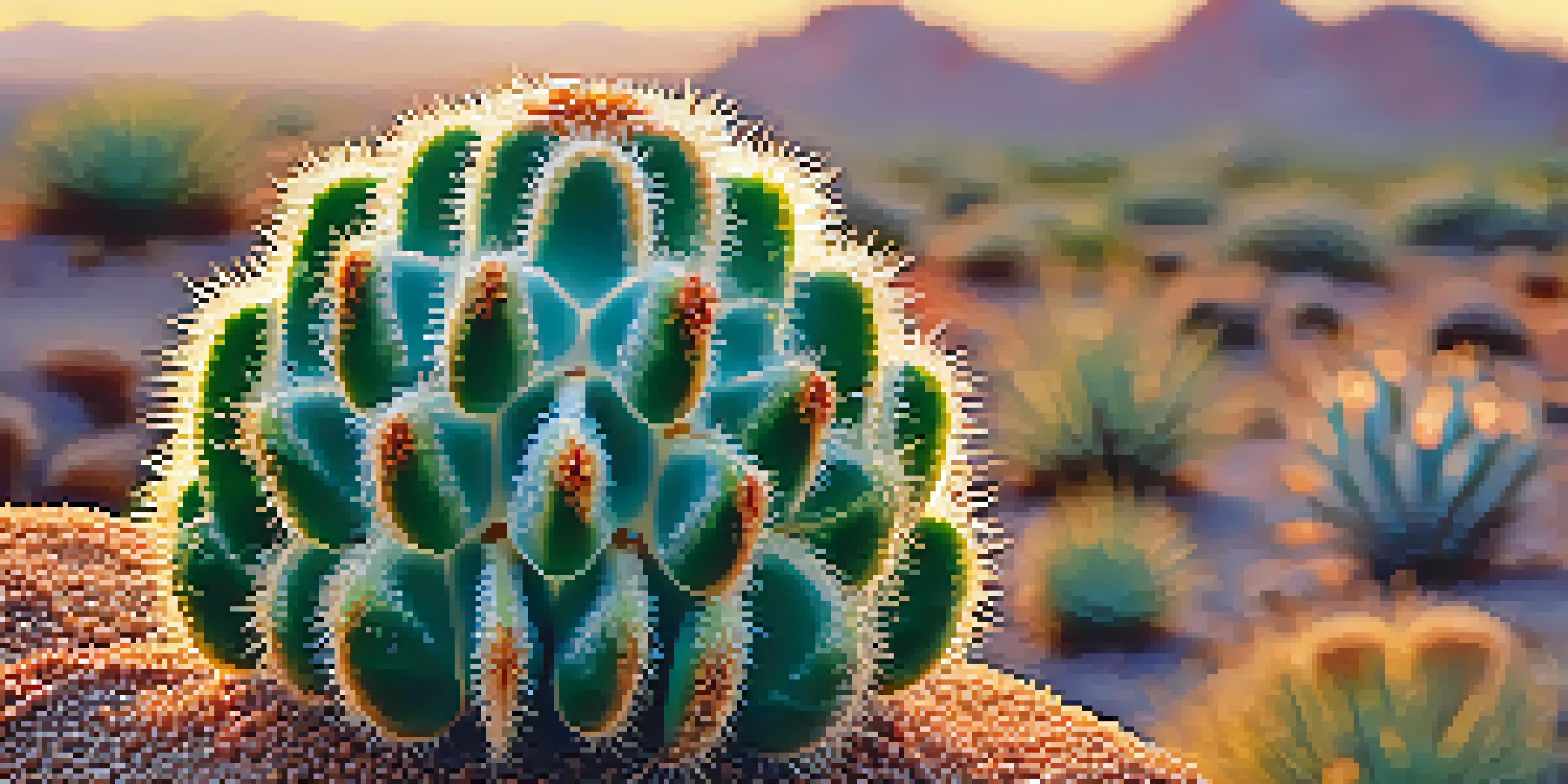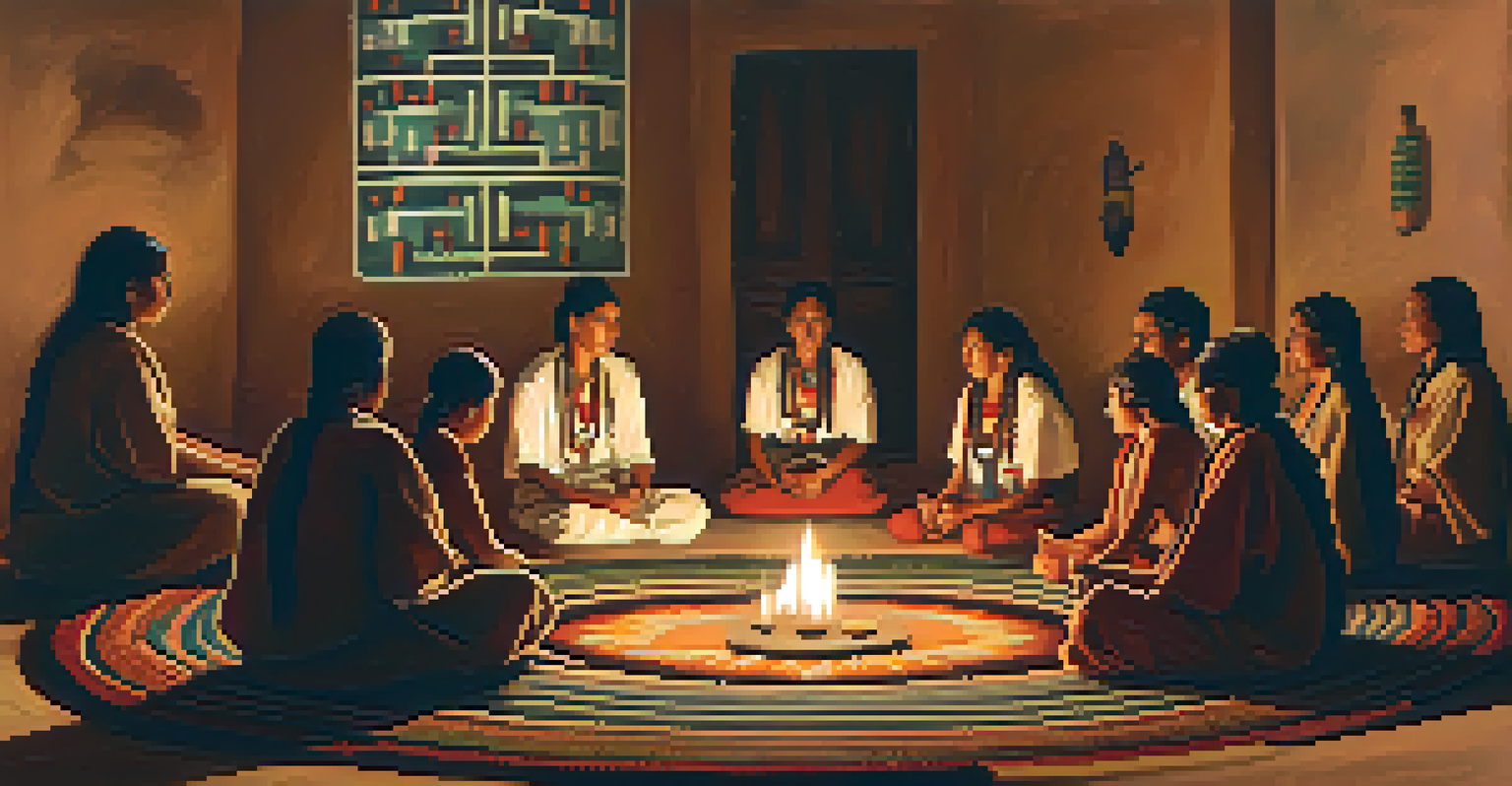The Role of Peyote in Indigenous Cultures and Rituals

Understanding Peyote: A Cactus with Deep Roots
Peyote, a small, spineless cactus native to Mexico and the southwestern United States, has been used for centuries in various Indigenous cultures. Its psychoactive properties come from a compound called mescaline, which has profound effects on perception and consciousness. For many Indigenous peoples, Peyote is not just a plant; it symbolizes a connection to the divine and the natural world, often serving as a sacred tool in spiritual practices.
Peyote is a sacred medicine that connects us to the spiritual world and our ancestors.
In many ways, Peyote acts as a bridge between the physical and spiritual realms. It has been used in rituals for healing, prayer, and community bonding. By consuming Peyote, individuals often seek clarity, guidance, and insight, allowing them to reflect on their lives and their roles within their communities.
The use of Peyote is deeply intertwined with the cultural identity of various tribes, particularly the Huichol, Navajo, and Lakota. For these communities, Peyote ceremonies are essential, fostering a sense of belonging and continuity of traditions that date back generations.
The Historical Significance of Peyote in Indigenous Life
Historically, Peyote has played a crucial role in Indigenous rituals and social structures. Archaeological evidence suggests that the use of Peyote dates back over 5,000 years, indicating its longstanding importance in spiritual practices. This deep historical connection underscores the plant's significance in shaping cultural identity and community cohesion among Indigenous peoples.

The arrival of European settlers marked a turning point in the perception of Peyote, often leading to misunderstandings and stigmas surrounding its use. Despite these challenges, Indigenous communities have continued to uphold their traditions, integrating Peyote into their spiritual practices as a means of resistance and resilience against colonial forces.
Peyote's Cultural Significance
Peyote symbolizes a deep spiritual connection for Indigenous communities, serving as a vital tool in their cultural and ceremonial practices.
Today, Peyote remains a symbol of cultural heritage and spiritual strength for many Indigenous peoples. Its historical significance is recognized not only as a plant for ritual but also as a testament to the enduring nature of Indigenous cultures in the face of adversity.
Peyote Rituals: A Journey of Healing and Discovery
Peyote rituals often take the form of ceremonies that involve prayer, singing, and community gathering. These rituals serve as a space for participants to seek healing, both physically and spiritually. The collective nature of these ceremonies fosters a sense of unity and shared purpose, allowing individuals to support one another in their journeys.
The preservation of our traditions is vital, not just for our identity but for the survival of our communities.
During a typical Peyote ceremony, participants consume the cactus in a controlled setting, guided by a knowledgeable leader or shaman. The experience can be deeply introspective, often leading to visions or insights that participants interpret as messages from the spirit world. These moments of clarity can help individuals navigate personal challenges and strengthen their connection to their culture.
Beyond individual healing, Peyote rituals often emphasize the importance of community well-being. By coming together to share experiences, participants reinforce their bonds and cultivate a sense of responsibility for one another, showcasing the interconnectedness that is central to many Indigenous cultures.
The Role of Peyote in Spiritual Practices
Peyote is often considered a sacrament in various Indigenous spiritual practices, holding a revered place in ceremonies. It is believed to facilitate communication with the divine, allowing participants to receive guidance and wisdom. This spiritual dimension of Peyote underscores its importance as more than just a tool for psychoactive experiences; it is a vital part of the spiritual fabric of many Indigenous communities.
The integration of Peyote in spiritual practices varies among different tribes, with each culture attributing unique meanings and rituals to its use. Some tribes, for instance, view Peyote as a means to connect with ancestors, while others see it as a way to gain insights into the mysteries of life. This diversity reflects the rich tapestry of beliefs surrounding Peyote and its role in Indigenous spirituality.
Challenges to Peyote Traditions
Overharvesting, habitat loss, and legal barriers pose significant threats to the sustainability of Peyote and the traditions surrounding its use.
Furthermore, the use of Peyote in spiritual practices has been acknowledged beyond Indigenous communities, gaining recognition in broader discussions about spirituality and consciousness. This growing interest highlights the importance of respecting and understanding the cultural contexts in which Peyote is used.
Challenges Facing Peyote Traditions Today
Despite its rich cultural significance, the use of Peyote is not without challenges. Overharvesting and habitat loss threaten the cactus's sustainability, raising concerns about its future in Indigenous rituals. This environmental issue highlights the need for conservation efforts and sustainable practices to ensure that Peyote remains available for future generations.
Additionally, legal and societal barriers continue to impact Indigenous peoples' rights to practice their Peyote traditions. In many places, the use of Peyote is restricted or misunderstood by non-Indigenous laws and communities. This can lead to a disconnect between Indigenous peoples and their spiritual practices, further complicating the preservation of their cultural heritage.
In response to these challenges, many Indigenous communities are actively working to advocate for their rights and educate the public about the importance of Peyote. By sharing their stories and perspectives, they seek to foster greater understanding and respect for their traditions, ensuring that Peyote remains a vital part of their cultural identity.
The Importance of Cultural Preservation
Cultural preservation is crucial for maintaining the traditions and practices associated with Peyote. As modern influences continue to infiltrate Indigenous communities, there is a growing need to safeguard these practices from erosion. By passing down knowledge and rituals related to Peyote, Indigenous peoples can ensure that their cultural heritage remains vibrant and alive.
Many communities are employing various strategies to preserve their Peyote traditions, including educational programs, workshops, and intergenerational storytelling. These initiatives not only promote awareness of the cultural significance of Peyote but also empower younger generations to take part in their heritage.
Importance of Cultural Preservation
Preserving Peyote traditions is essential for maintaining Indigenous identity and fostering pride within communities amid modern influences.
The act of preserving these traditions is about more than just maintaining practices; it's also about fostering a sense of identity and pride within Indigenous communities. By celebrating their connection to Peyote, these communities can continue to thrive and assert their place in the broader cultural landscape.
Looking Ahead: The Future of Peyote in Indigenous Cultures
As we look to the future, the role of Peyote in Indigenous cultures will likely continue to evolve. With a growing interest in Indigenous spirituality and practices, there is potential for greater recognition and respect for the significance of Peyote. This shift could lead to more inclusive discussions about the plant's role in cultural identity and spirituality.
However, this increased visibility must be approached with caution and sensitivity. It is essential to prioritize the voices of Indigenous peoples and ensure that their traditions are honored and respected. Engaging in open dialogues about the challenges and triumphs surrounding Peyote can help foster a better understanding among non-Indigenous communities.

Ultimately, the future of Peyote in Indigenous cultures hinges on a collective commitment to cultural preservation, sustainability, and respect. By working together, we can ensure that this sacred cactus continues to thrive as a vital part of Indigenous heritage for generations to come.